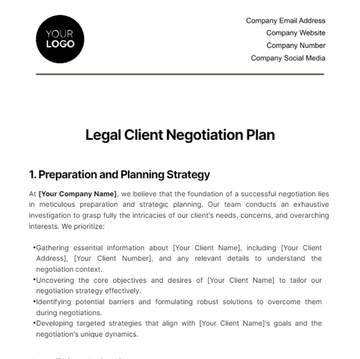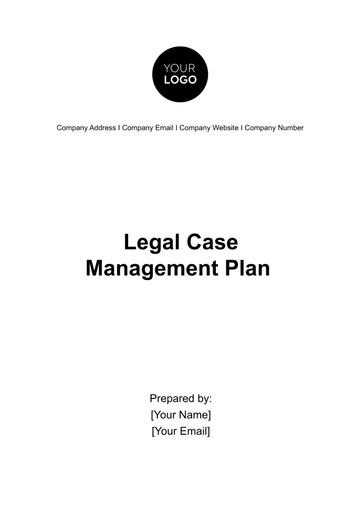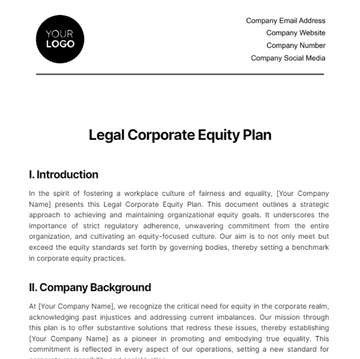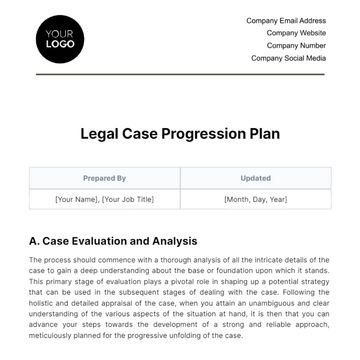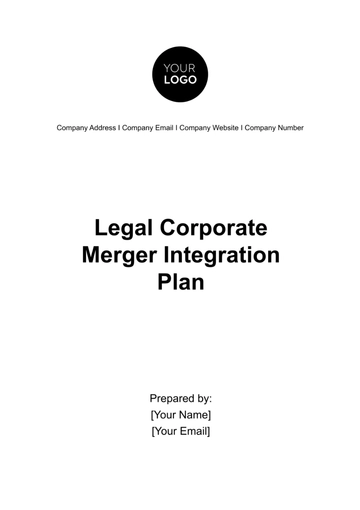Free Legal Case Management Plan

I. Introduction
This document outlines the Legal Case Management Plan for [Your Company Name], intended to establish a structured approach for handling legal matters. Our goal is to ensure a systematic, coherent process for managing potential or ongoing legal issues, thereby safeguarding our business interests and maintaining operational integrity.
II. Objectives
In an often unpredictable landscape of business operations, legal challenges can emerge as significant hurdles, potentially derailing progress and impacting the bottom line. Recognizing this, [Your Company Name] has meticulously crafted objectives within its Legal Case Management Plan to not only address such challenges head-on but also to preemptively safeguard the organization's interests and ensure sustained growth. These objectives are foundational to our approach, shaping the very fabric of our legal operations and strategy.
1. Efficiency
In today's fast-paced business environment, efficiency is not just a goal; it's a necessity. By streamlining our legal case management workflow, we aim to significantly enhance our responsiveness to legal issues and optimize our resource allocation. This is not merely about speeding up processes but about smartly integrating technology, expertise, and best practices to create a seamless legal machinery that operates with precision and agility. Our focus here is on minimizing downtime, reducing redundancies, and ensuring that our legal resources are deployed in the most impactful manner.
2. Tracking
Visibility into ongoing legal cases is akin to having a high-powered radar in a storm; it allows us to navigate with confidence and clarity. Implementing a robust system for monitoring legal cases ensures that we are always ahead of the curve, capable of making informed decisions swiftly. This involves not just tracking the progress of each case but also understanding its nuances and potential implications on our operations. Timely interventions become possible with such a system in place, allowing us to address issues before they escalate, thereby maintaining the continuity of our business processes.
3. Risk Mitigation
In the realm of business, risk is an ever-present companion, more so when it comes to legal matters. Proactively addressing legal risks is a strategic imperative for [Your Company Name], aimed at minimizing their impact on our operations and reputation. This involves a comprehensive approach, encompassing regular legal audits, staying abreast of regulatory changes, and fostering a culture of compliance. By identifying potential legal pitfalls before they manifest and crafting strategies to navigate or avoid them, we protect our organizational fabric from unwarranted disruptions.
4. Protection
The cornerstone of our legal strategy is the protection of our business from potential legal challenges. This goes beyond mere defensive measures; it's about building a fortress of preemptive planning and strategic action that shields our interests from legal adversities. Whether it's intellectual property issues, contractual disputes, or regulatory compliance, our focus is on creating a robust legal framework that deters challenges and ensures our business operates within a secure legal boundary.
5. Guidance
Consistency and compliance are the hallmarks of a well-oiled legal framework. By offering clear, definitive directives on how legal cases should be handled, we aim to instill a sense of uniformity and reliability across the organization. This guidance serves as a beacon for our teams, ensuring that every legal action and decision is aligned with our overarching principles and compliance standards. It's about empowering our personnel with the knowledge and tools they need to navigate legal complexities confidently.
III. Case Intake Process
At the heart of our Legal Case Management Plan lies the Case Intake Process, a meticulously designed gateway through which all potential legal issues pass. This initial phase is critical, setting the tone and direction for how a case is managed through its lifecycle.
1. Initial Documentation
The first step in our intake process is the comprehensive documentation of the issue at hand. This involves a detailed recording of all pertinent details, including the parties involved, the nature of the legal matter, and any preliminary facts or evidence that have been gathered. This documentation serves as the foundation of the case file, providing a clear and concise overview of the matter, which is crucial for subsequent analysis and decision-making.
2. Assessment
Following the initial documentation, an in-depth assessment of the case is conducted to determine its relevance and potential impact on [Your Company Name]. This evaluation is not just about the legal merits of the case but also involves a strategic analysis of how the issue aligns with or contradicts our business objectives and values. The outcome of this assessment guides the prioritization of the case and the allocation of resources, ensuring that our legal efforts are directed where they are most needed and can have the greatest positive effect on our operations.
IV. Case Organization
The backbone of [Your Company Name]'s Legal Case Management Plan is its robust case organization system. This system is designed to uphold the integrity and accessibility of legal documentation, ensuring that every piece of information is accounted for and readily available to those who need it. The organization of cases is a multi-faceted process, involving the meticulous establishment of digital case files and the strategic use of case management software.
1. Case Files
At the core of our case organization efforts are our digital case files. For each legal matter that arises, a unique digital file is created. This file serves as a centralized repository for all documents, correspondence, and other relevant information pertaining to the case. The establishment of these files is the first step in ensuring that our legal documentation is secure, organized, and easily retrievable. By maintaining a digital format, we not only enhance the efficiency of information retrieval but also contribute to the sustainability goals of [Your Company Name] by reducing paper usage.
Case Management System
To complement our digital case files, [Your Company Name] employs a sophisticated Legal Case Management Software. This technology is not just a tool but a strategic asset that streamlines case tracking, document management, and communication with stakeholders. The software provides a unified platform where all case-related information is aggregated, allowing for real-time updates and access. Its deployment facilitates the seamless management of cases, from intake through resolution, ensuring that every case is handled with the diligence and attention it deserves.
V. Legal Team Roles & Responsibilities
A well-defined legal team structure is pivotal to the effective management of legal matters. At [Your Company Name], we have established clear roles and responsibilities within our legal department to ensure clarity, efficiency, and accountability in our operations. This structure is designed to leverage the strengths and expertise of our team members, fostering an environment of collaboration and excellence.
1. Lead Counsel
The Lead Counsel is at the helm of our legal operations, responsible for guiding the strategic direction of our legal affairs. This role involves overseeing the development of case strategies and making critical decisions that affect the outcome of legal matters. The Lead Counsel ensures that our legal actions are not only reactive but also proactive, aligning with the broader business objectives of [Your Company Name]. Their leadership is crucial in navigating complex legal landscapes and upholding our company's reputation and interests.
2. Case Managers
Case Managers are the linchpins of our day-to-day legal operations. They are tasked with the hands-on management of legal cases, ensuring that each case progresses according to plan and adheres to established timelines and procedural norms. Their responsibilities include coordinating with various stakeholders, managing documentation, and facilitating the resolution of cases. Through their diligent oversight, Case Managers maintain the momentum of legal processes, ensuring that no detail is overlooked and that every action taken is in the best interest of [Your Company Name].
3. Support Staff
The Support Staff play a crucial role in the backbone of our legal department, providing essential administrative and logistical support. Their efforts in document management, scheduling, and communication are indispensable to the smooth operation of the legal team. By handling these critical tasks, the Support Staff enable the Lead Counsel and Case Managers to focus on strategic and case-specific challenges, thereby enhancing the overall efficiency and effectiveness of our legal operations.
VI Communication and Collaboration Plan
Communication and collaboration are the threads that bind everything together. [Your Company Name] has instituted a comprehensive communication and collaboration plan to ensure that information flows seamlessly among team members, stakeholders, and clients. This plan is designed to foster a culture of transparency, alignment, and collective effort towards the resolution of legal matters.
1. Regular Updates
To keep all relevant parties informed and engaged, [Your Company Name] has instituted a schedule of regular updates. These updates are structured briefings that provide concise yet comprehensive overviews of case progress, key developments, and any challenges encountered. By maintaining a rhythm of consistent communication, we ensure that stakeholders are not only informed but also involved in the legal process, fostering a sense of partnership and collaboration.
2. Collaboration Tools
In today’s digital age, the ability to collaborate effectively across different geographies and time zones is essential. Recognizing this, [Your Company Name] has adopted a suite of Communication Apps designed to facilitate real-time, effective teamwork and information exchange. These tools enable our legal team to collaborate with internal departments, external partners, and clients in a dynamic, interactive environment. Whether it's sharing documents, conducting meetings, or brainstorming strategies, our collaboration tools ensure that our team remains connected and cohesive, regardless of physical location.
VII. Case Tracking and Monitoring
In the intricate landscape of legal case management, the ability to track and monitor each case effectively is paramount. At [Your Company Name], we have established a dedicated system for this purpose, designed to uphold the highest standards of diligence and precision in our legal operations. This system is the cornerstone of our proactive approach, enabling us to maintain control over the trajectory of each case and ensuring that our legal strategies are executed flawlessly.
1. Monitor Progress
Our case tracking system is engineered to provide real-time visibility into the progress of each legal matter. By setting clear benchmarks and timelines at the outset, we can meticulously monitor the advancement of cases, ensuring that they are progressing as planned. This constant vigilance allows us to quickly identify any deviations or delays, enabling timely intervention to realign case trajectories with our strategic objectives. This proactive stance not only enhances our efficiency but also significantly reduces the risk of unforeseen complications impacting our legal outcomes.
2. Update Mechanisms
To complement our progress monitoring, [Your Company Name] has instituted robust update mechanisms within our case management system. These mechanisms are designed to facilitate regular, structured updates, ensuring that all relevant parties are consistently informed about the status of ongoing legal matters. This level of transparency fosters a collaborative environment, where decision-makers, stakeholders, and legal teams are in sync, enhancing our collective ability to respond to developments with agility and informed precision.
VIII. Risk Mitigation
Risk mitigation is a critical component of our legal strategy, reflecting our commitment to safeguarding [Your Company Name]'s interests against potential legal vulnerabilities. Our approach to risk mitigation is multifaceted, incorporating regular compliance audits and the continuous monitoring of legal developments, ensuring that our practices not only meet current legal standards but also anticipate future changes.
1. Compliance Audits
At the heart of our risk mitigation strategy are our compliance audits. These audits are conducted regularly, scrutinizing our legal processes and case handling to ensure they adhere to regulatory requirements and reflect best practices. By systematically reviewing our legal operations, we can identify areas of potential risk or non-compliance, enabling us to implement corrective measures proactively. This ongoing commitment to compliance fortifies our legal foundation, ensuring that our business operations are conducted within a secure and ethical legal framework.
2. Legal Updates
The legal landscape is ever-evolving, with new legislation, regulations, and precedents continually shaping the environment in which we operate. To navigate this dynamic terrain, [Your Company Name] maintains a vigilant eye on legal developments, ensuring that our strategies and practices are not only current but also forward-looking. This continuous monitoring enables us to preemptively adjust our legal approaches, minimizing potential risks and ensuring that our operations remain compliant and resilient in the face of change.
IX. Reporting
Transparency and accountability are the pillars upon which our reporting protocols are built. At [Your Company Name], we understand the importance of clear, concise reporting in maintaining trust and alignment among all stakeholders. Our reporting protocols are designed to provide insightful, actionable information, ensuring that both internal and external parties are well-informed about our legal activities and their implications.
1. Internal Reporting
For our internal stakeholders, periodic reports are prepared, summarizing the status, milestones, and challenges associated with each case. These reports serve as a comprehensive overview, enabling informed decision-making and strategic planning. By maintaining a regular reporting cadence, we ensure that our leadership and relevant departments are aligned with our legal initiatives, fostering a cohesive approach to addressing legal matters.
2. External Reporting
Where necessary, [Your Company Name] also prepares external reports, providing summaries and updates on legal cases to parties outside the organization. These reports are crafted with a keen awareness of confidentiality and compliance requirements, ensuring that sensitive information is protected while maintaining the necessary level of transparency with our external partners and stakeholders.
X. Case Closure and Review
The conclusion of a legal case marks not the end but a pivotal moment of reflection and learning for [Your Company Name]. Our case closure and review protocols are integral to our continuous improvement philosophy, ensuring that each case contributes to the refinement and enhancement of our legal practices.
1. Closure Protocol
Our formal closure protocol ensures that each case is concluded systematically, with all legal and procedural requirements meticulously fulfilled. This process involves a thorough review of the case, ensuring that all obligations have been met, and that the resolution is documented and communicated appropriately. This disciplined approach to case closure safeguards our interests and maintains the integrity of our legal operations.
2. Post-Case Review
Following the closure of a case, a comprehensive review is conducted to evaluate our handling of the matter. This post-case review is an opportunity for introspection and learning, aimed at distilling key insights and lessons learned from the case. By examining our strategies, decisions, and outcomes, we can identify areas for improvement, best practices to be reinforced, and innovative approaches to be explored. This continuous cycle of review and refinement is a testament to our commitment to excellence in legal case management, ensuring that with each case, our capabilities are enhanced, and our strategies are more finely tuned to the dynamic demands of the legal landscape.
XI. Technology Tools
In an era where technology plays a central role in enhancing operational efficiency and effectiveness, [Your Company Name] recognizes the transformative impact of leveraging cutting-edge tools in our legal case management processes. The adoption of specialized technology tools is not just an operational decision; it's a strategic one, enabling us to navigate the complexities of legal management with greater agility, accuracy, and security.
Our carefully selected suite of technology tools is integral to our legal operations, each serving a specific purpose that contributes to the overarching goal of optimizing our legal case management framework. From streamlining document organization to facilitating seamless communication among team members, these tools are at the forefront of our efforts to enhance the responsiveness and effectiveness of our legal department.
The following table provides an overview of the key technology tools employed by [Your Company Name], outlining their primary functions and the benefits they bring to our legal case management practices. This strategic integration of technology not only empowers our legal team but also reinforces our commitment to maintaining the highest standards of efficiency, security, and compliance in our legal operations.
Name | Function | Benefit |
|---|---|---|
Legal Case Management Software | Digital organization and management of case files | Increases efficiency; reduces file misplacement risks |
Communication Apps | Facilitates team communication | Enhances collaboration; ensures timely information exchange |
Time Tracking Tools | Records time spent on cases | Enables accurate billing; improves productivity assessment |
Document Management Software | Secure document storage and access | Mitigates document loss; prevents unauthorized access |
Data Security Tools | Ensures legal information protection | Minimizes data breach risks; safeguards sensitive data |
As we conclude this Legal Case Management Plan, it is important to reiterate [Your Company Name]'s unwavering commitment to excellence, integrity, and innovation in managing legal affairs. This document is more than just a set of guidelines; it is a reflection of our proactive approach to anticipating and addressing legal challenges, safeguarding our business interests, and upholding our reputation in the industry.
The strategies, processes, and tools outlined in this plan are designed to provide a comprehensive framework for managing legal cases, from inception to closure. However, we recognize that the legal landscape is ever-evolving, and as such, this plan is a living document, subject to review and adaptation to meet changing legal requirements, business needs, and technological advancements.
In our pursuit of continuous improvement, we welcome feedback, insights, and suggestions from all stakeholders involved in the legal process. Collaboration, after all, is key to our success, and it is through collective effort that we can achieve our goals and overcome challenges.
Let this plan serve as both a roadmap and a commitment—a commitment to operational excellence, legal compliance, and strategic foresight. Together, we will navigate the complexities of legal case management with confidence, ensuring that [Your Company Name] continues to thrive in a competitive and ever-changing business environment.
Thank you to all who contribute to the meticulous management and resolution of our legal matters. Your dedication, expertise, and collaborative spirit are invaluable to the continued success and integrity of [Your Company Name].
For further information or clarification, please contact:
[Your Name]
[Your Email]
[Your Company Name]
[Your Company Email]
[Your Company Address]
[Your Company Number]
[Your Company Website]
[Your Company Social Media]
This document is confidential and intended for internal use by [Your Company Name] personnel only.
- 100% Customizable, free editor
- Access 1 Million+ Templates, photo’s & graphics
- Download or share as a template
- Click and replace photos, graphics, text, backgrounds
- Resize, crop, AI write & more
- Access advanced editor
Optimize your legal case management with Template.net's Legal Case Management Plan Template. Utilize our dynamic AI editor tool to tailor the plan to the specifics of your case. Effortlessly customize the content to outline strategies, timelines, and resource allocation. With editable features, ensure flexibility and adaptability to evolving circumstances. Elevate your case management with precision and efficiency, driving favorable outcomes for your clients.
You may also like
- Finance Plan
- Construction Plan
- Sales Plan
- Development Plan
- Career Plan
- Budget Plan
- HR Plan
- Education Plan
- Transition Plan
- Work Plan
- Training Plan
- Communication Plan
- Operation Plan
- Health And Safety Plan
- Strategy Plan
- Professional Development Plan
- Advertising Plan
- Risk Management Plan
- Restaurant Plan
- School Plan
- Nursing Home Patient Care Plan
- Nursing Care Plan
- Plan Event
- Startup Plan
- Social Media Plan
- Staffing Plan
- Annual Plan
- Content Plan
- Payment Plan
- Implementation Plan
- Hotel Plan
- Workout Plan
- Accounting Plan
- Campaign Plan
- Essay Plan
- 30 60 90 Day Plan
- Research Plan
- Recruitment Plan
- 90 Day Plan
- Quarterly Plan
- Emergency Plan
- 5 Year Plan
- Gym Plan
- Personal Plan
- IT and Software Plan
- Treatment Plan
- Real Estate Plan
- Law Firm Plan
- Healthcare Plan
- Improvement Plan
- Media Plan
- 5 Year Business Plan
- Learning Plan
- Marketing Campaign Plan
- Travel Agency Plan
- Cleaning Services Plan
- Interior Design Plan
- Performance Plan
- PR Plan
- Birth Plan
- Life Plan
- SEO Plan
- Disaster Recovery Plan
- Continuity Plan
- Launch Plan
- Legal Plan
- Behavior Plan
- Performance Improvement Plan
- Salon Plan
- Security Plan
- Security Management Plan
- Employee Development Plan
- Quality Plan
- Service Improvement Plan
- Growth Plan
- Incident Response Plan
- Basketball Plan
- Emergency Action Plan
- Product Launch Plan
- Spa Plan
- Employee Training Plan
- Data Analysis Plan
- Employee Action Plan
- Territory Plan
- Audit Plan
- Classroom Plan
- Activity Plan
- Parenting Plan
- Care Plan
- Project Execution Plan
- Exercise Plan
- Internship Plan
- Software Development Plan
- Continuous Improvement Plan
- Leave Plan
- 90 Day Sales Plan
- Advertising Agency Plan
- Employee Transition Plan
- Smart Action Plan
- Workplace Safety Plan
- Behavior Change Plan
- Contingency Plan
- Continuity of Operations Plan
- Health Plan
- Quality Control Plan
- Self Plan
- Sports Development Plan
- Change Management Plan
- Ecommerce Plan
- Personal Financial Plan
- Process Improvement Plan
- 30-60-90 Day Sales Plan
- Crisis Management Plan
- Engagement Plan
- Execution Plan
- Pandemic Plan
- Quality Assurance Plan
- Service Continuity Plan
- Agile Project Plan
- Fundraising Plan
- Job Transition Plan
- Asset Maintenance Plan
- Maintenance Plan
- Software Test Plan
- Staff Training and Development Plan
- 3 Year Plan
- Brand Activation Plan
- Release Plan
- Resource Plan
- Risk Mitigation Plan
- Teacher Plan
- 30 60 90 Day Plan for New Manager
- Food Safety Plan
- Food Truck Plan
- Hiring Plan
- Quality Management Plan
- Wellness Plan
- Behavior Intervention Plan
- Bonus Plan
- Investment Plan
- Maternity Leave Plan
- Pandemic Response Plan
- Succession Planning
- Coaching Plan
- Configuration Management Plan
- Remote Work Plan
- Self Care Plan
- Teaching Plan
- 100-Day Plan
- HACCP Plan
- Student Plan
- Sustainability Plan
- 30 60 90 Day Plan for Interview
- Access Plan
- Site Specific Safety Plan



